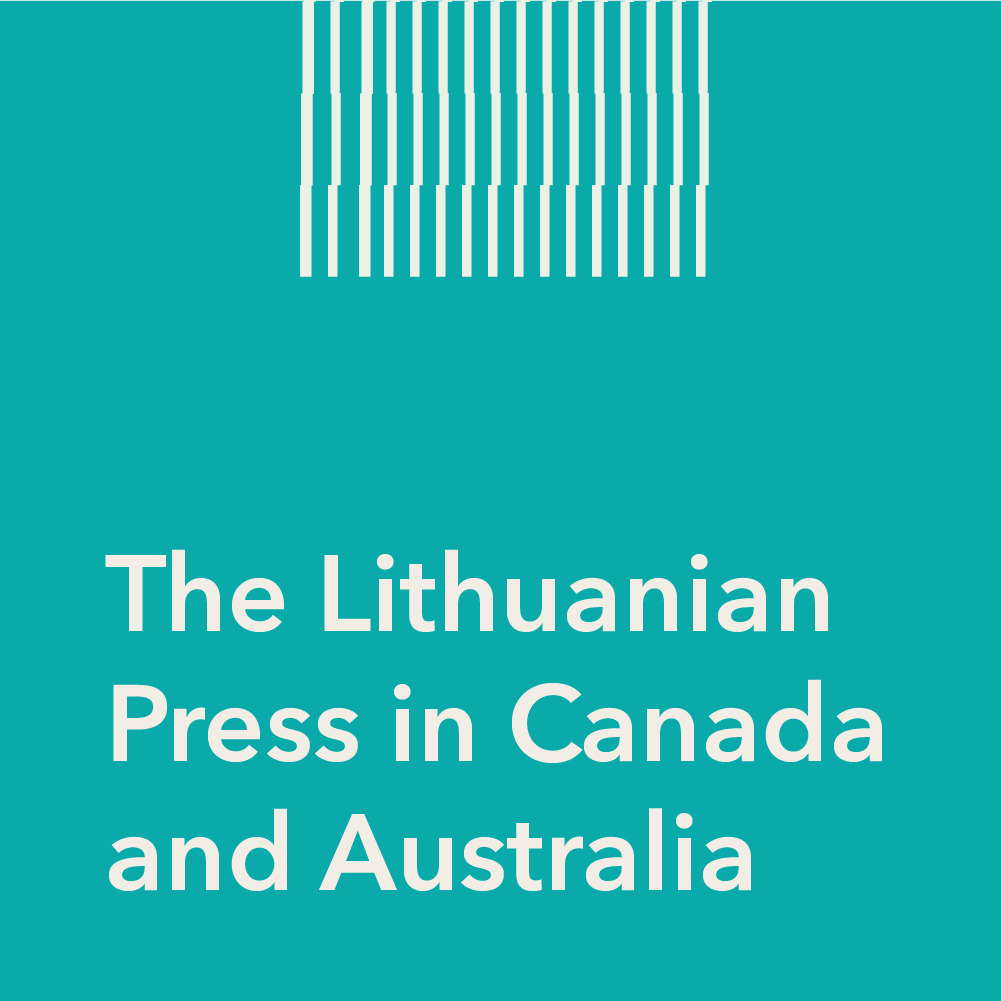-
-
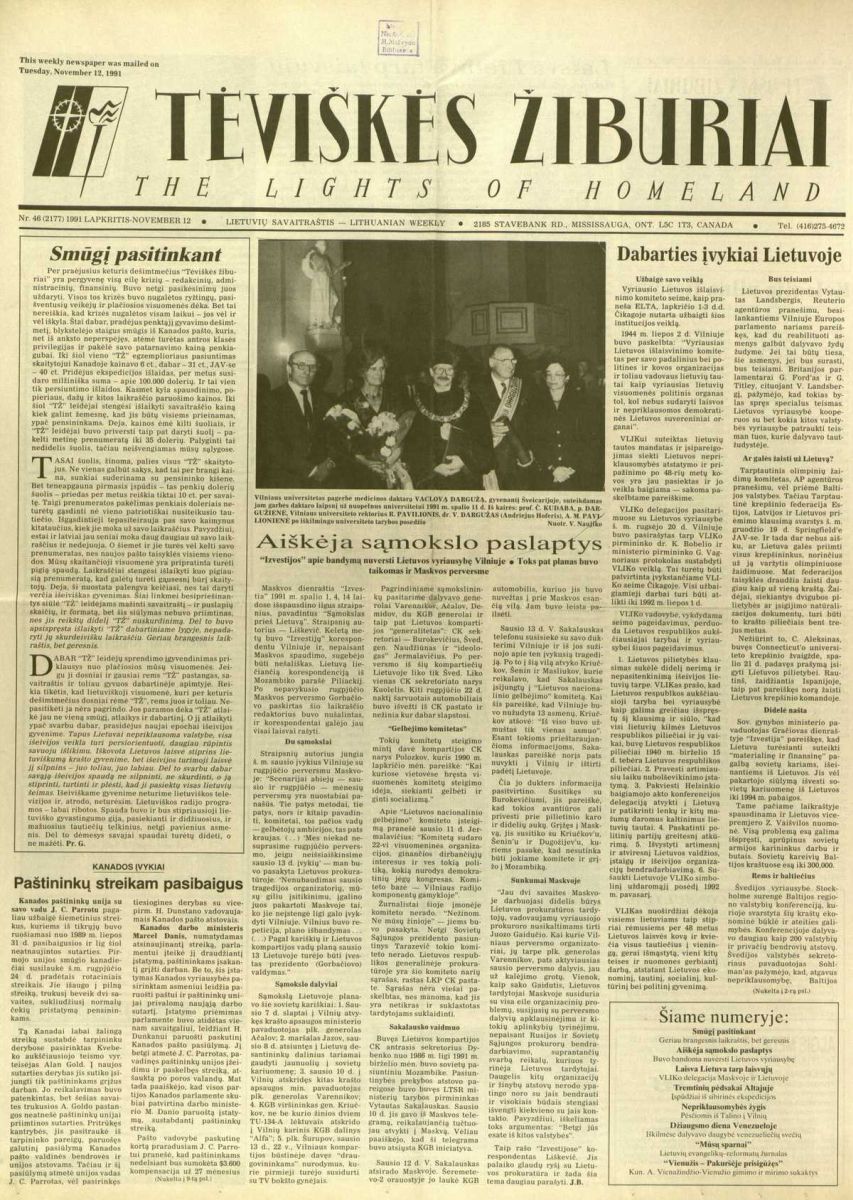
The November 12, 1991, editorial in the Lights of Homeland discusses the status and issues regarding the use of the Lithuanian language in Canada.
The Lights of Homeland
Tėviškės žiburiai
In many ways the Lights of Homeland, the patriotic weekly which began publication in 1949, was the Canadian counterpart of the Friend published in Chicago. However the Lights of Homeland was established by the second wave of Lithuanian immigrants coming to Canada after World War II. The publishers were the Lithuanian Canadian Catholic Cultural Society “Žiburiai”. Content was political, cultural, literary and religious, and included the discussion of issues relevant to both Lithuania and the diaspora. At various points there were sections dedicated to women, youth, and children. Editorial policy dictated a high standard of Lithuanian language and content.
The weekly celebrated its 70th anniversary in 2019, a relatively long lifespan, but changes in editorial staff had been few. Of four editors-in-chief, the last two were women (Ramūnė Jonaitienė and Sigina Katkauskaitė). Defending the position of the weekly vis-à-vis its status in the media and the arrival of the internet, editor Česlovas Senkevičius wrote in 1990 (April 7), that “our main concern is not as much rapid transmission of news as a Lithuanian viewpoint and reaction to every world event, especially regarding Lithuania and its diaspora… In that sense, our publication plays a specific role in maintaining a particular orientation”.
In 2005 the newspaper changed from a large (metro) format to a smaller, tabloid size. Senkevičius commented on that, saying that in this new framework, “our joys and sorrows remain the same, and our mission is the same – to maintain the Christian Lithuanian worldview”. Due to falling readership and increasing costs, it was published every two weeks for over a year, until the board decided to stop printing and move to the website alone in July 2020. News and other information are available on the website www.tevzib.com in both Lithuanian and English, with a weekly electronic newsletter highlighting new material, both free of charge.
Digital issues of the Lights of Homeland up to 2010 are available on the portal epaveldas.lt.
Read more about the Lights of Homeland in an interview with one of the editors. -
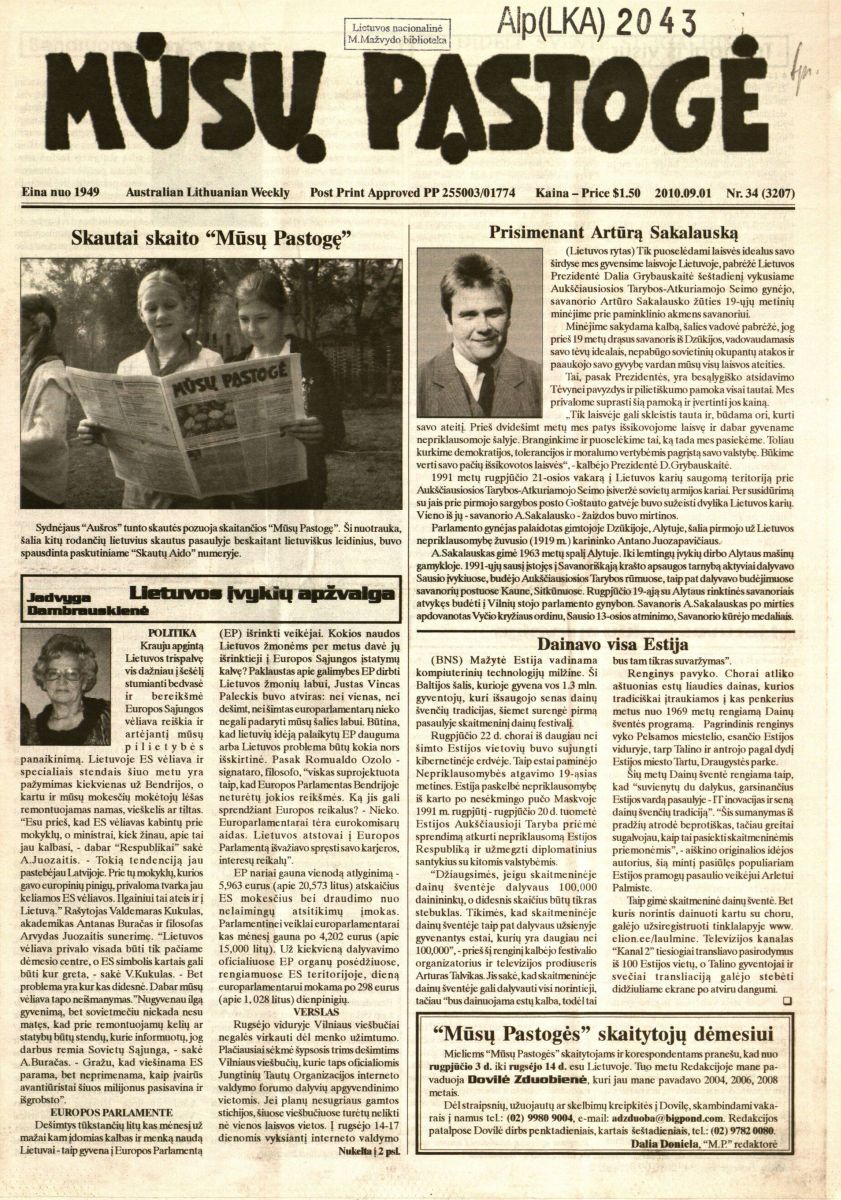
The front page of Our Haven, September 1, 2010, shows a photo of Australian Scouts reading the weekly.
Our Haven
Mūsų pastogė
The Australian Lithuanian Society (later the Australian Lithuanian Community) began publishing the weekly Our Haven in 1949. It was the first Lithuanian-language newspaper in Australia. Its mission never changed: to serve as the voice of the Australian Lithuanian Society, to assist Australian Lithuanians by providing them with in-depth political, cultural and financial information. The newspaper, which celebrated its 70th anniversary last year, has changed very little in format and remains a weekly. Content is mostly about Lithuanian community events, with cultural and sports news as well.
As the newspaper grew, several supplements came and went, such as the satyrical Your Haven, April Fools’ Day issues, and literary and cultural editions such as “Flights of Fancy” and “Outside the Daily Grind”, which was published in English. The Australian Lithuanian Students, Scouts and the Melbourne Women’s Social Assistance Society also had supplements at various times.
As is true for much of the press established by the first and second wave of Lithuanian immigrants in the diaspora, Our Haven has been affected by changing generations and the problem of declining readership. According to the current editor-in-chief Dalia Doniela, there are fewer readers because most subscribers are seniors. In 2001 there were 800 subscribers, and in 2014 – 200 fewer. And of course this has a negative effect on the newspaper’s finances. Today Our Haven continues to survive not on the basis of subscriptions, but because of donations and bequests from readers. Since 1977 the publishers are the Australian Lithuanian Community Press Association, and the general opinion is that before long Our Haven will migrate to the internet. Romas Cibas, chair of the board of publishers, said in a 2014 interview that his goal is to do that, in order to attract the younger generation. Six years after that interview, Our Haven is one of the “last Mohicans” of printed news in Lithuanian.
Digitized issues of Our Haven up to 2010 are available on epaveldas.lt. -
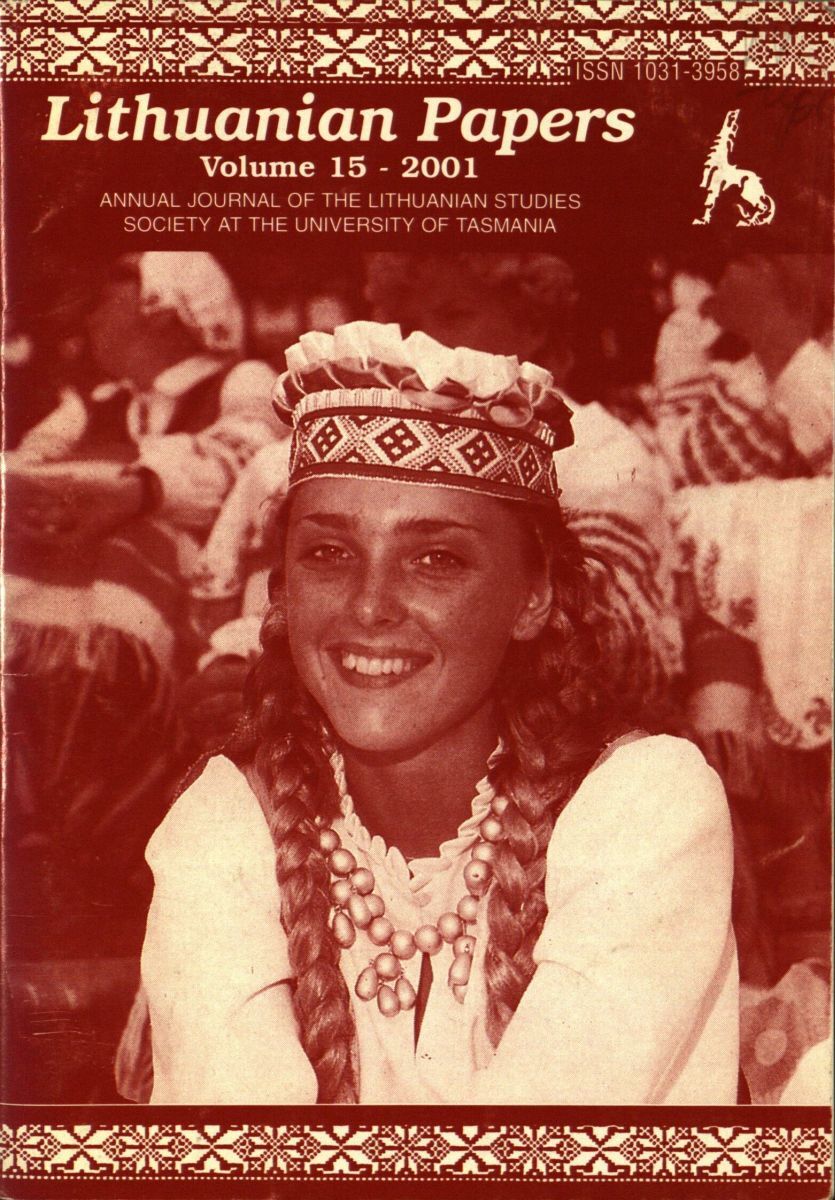
Cover of Lithuanian Papers, No. 15, 2001
Lithuanian Papers
The Lithuanian Studies Society, a group of Australian Lithuanian students at the University of Tasmania, began the magazine Lithuanian Papers in 1987. This was the only Lithuanian academic journal published in English in the Southern Hemisphere. That year, the Society had begun holding lectures about Lithuania by faculty as well as guest speakers, and realized that most of the papers were not being published. The best of the Lithuanian studies were then collected in a separate annual publication, even though financial and human resources were scarce. Today it is published with a circulation of 3,000 sent to other Australian states and 26 countries abroad. Editor Prof. Algimantas Patricius Taškūnas has published 32 issues of Lithuanian Papers to date.
The magazine prints the newest papers in the field of Lithuanian studies presented at the University of Tasmania, Australia and elsewhere. When space allows, Lithuanian Papers includes general articles on Lithuanian culture, history and other topics. Most contributors are Australians, Lithuanians from abroad or students at the University of Tasmania. A few of the first issues were compiled by Prof. Taškūnas and John W. Doyle. Recently the magazine has been transferred online at lithuanianpapers.com. All issues are available here. Visitors have not been overly responsive yet, although a few comments have appeared, for example by Aldona Bagusauskas, who wrote when the 2019 issue of Lithuanian Papers came out that she was glad to see the magazine again, and to read it on the internet.
Lithuanian Papers on the portal epaveldas.lt (up to 2008). -
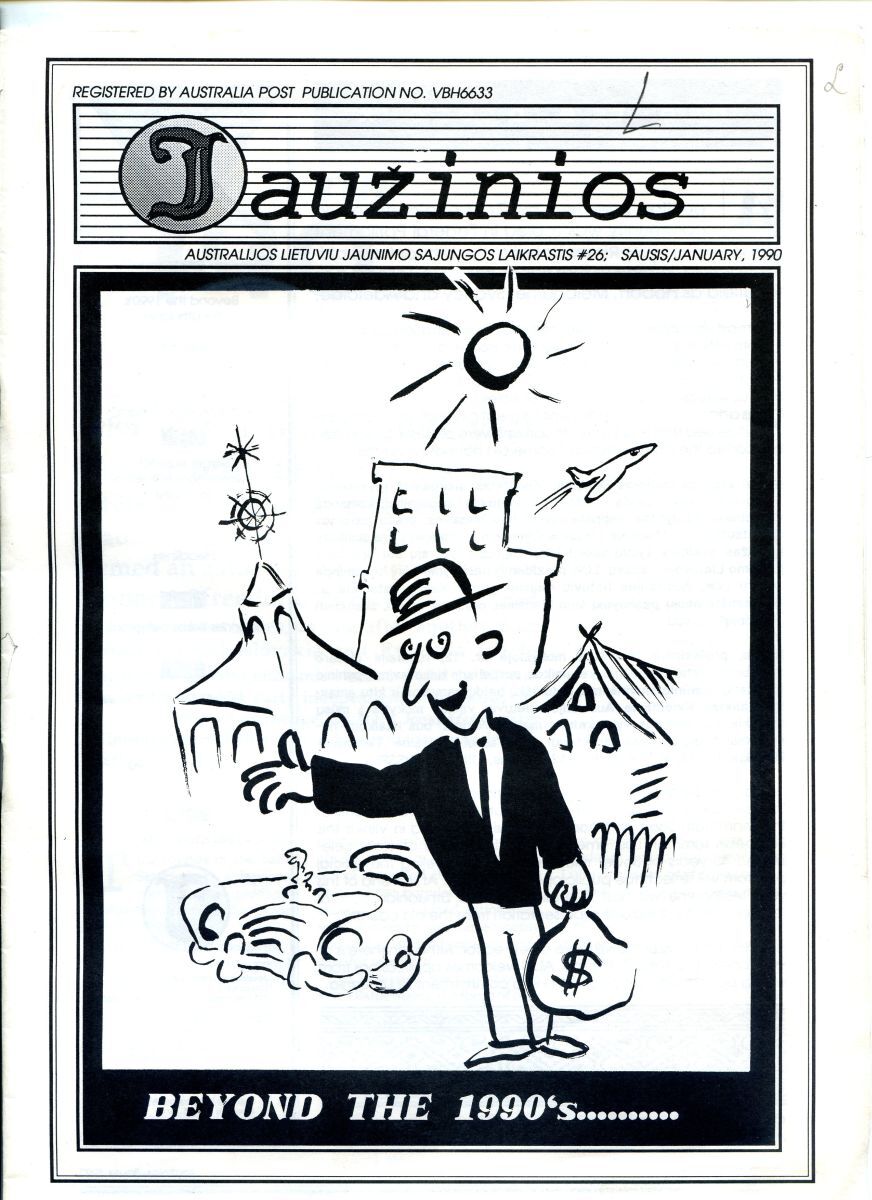
YouthNews cover, No. 26, 1990
YouthNews
JauŽinios
According to the first editor, John Mašanauskas, the publication began after a decision taken by the 1984 World Lithuanian Youth Congress concerning the necessity for Australian Lithuanian youth to have a newspaper. J. Mašanauskas, a professional journalist, was editor for six years, and reflected the mood of the Lithuanian diaspora and its press leading up to 1990. This young Australian Lithuanian took Lithuanian language courses for foreign students at the Vilnius University, attended Sąjūdis (Rebirth Movement) demonstrations, and wrote about political changes in Lithuania for YouthNews and the Australian media.
In his correspondence with Egle Karalienė, staff member of the National Library, the first editor highlighted the input of Melbourners Petras Kružas, Ray Vyšniauskas, and Mindaugas (Min) Simankevičius. In spring 1990, M. Simankevičius took over from J. Mašanauskas, and in 1993 the latter was replaced by an editorial threesome: Aidas Antanaitis, Australian Tim Fagan and Lukas Zdanius. Zdanius wrote that he took the job on reluctantly, but when Antanaitis and Fagan left, he had to edit the magazine himself, and remembers how he had to beg for articles. Ironically, quite a few articles came from Lithuania. In particular, he was grateful to R. Vyšniauskas, Brigita Karazija, Johnny Rukšėnas, and Albertas Zubras, an intellectual of the older generation. Zdanius also noted that the Lithuanian Community Credit Union “Talka” and the Lukaitis legal firm were always very supportive, as were the newsletter’s faithful suscribers. He mentioned that he had “big shoes to fill” when he took over editorial duties from Mašanauskas and Simankevičius.
Šarūnas Vaitkus, son of Lithuanian director Jonas Vaitkus, came to Australia in 1989 and joined the Lithuanian community in Melbourne. When Zdanius left the position in 1998, Vaitkus took on editing YouthNews. He wanted to renew the design, format and content of the publication. He described it as one person’s volunteer work, squeezed in after work, evenings and weekends. It was a one man show, because it fell to him to do not only layout, but marketing and fundraising as well. He recounted some strange incidents: in 1999 a long article about the etymology of Russian swear words and their use in Lithuanian caused an angry backlash and a storm of gossip. At the turn of the millenium, YouthNews, by then its name abbreviated to YN, stopped publication. -
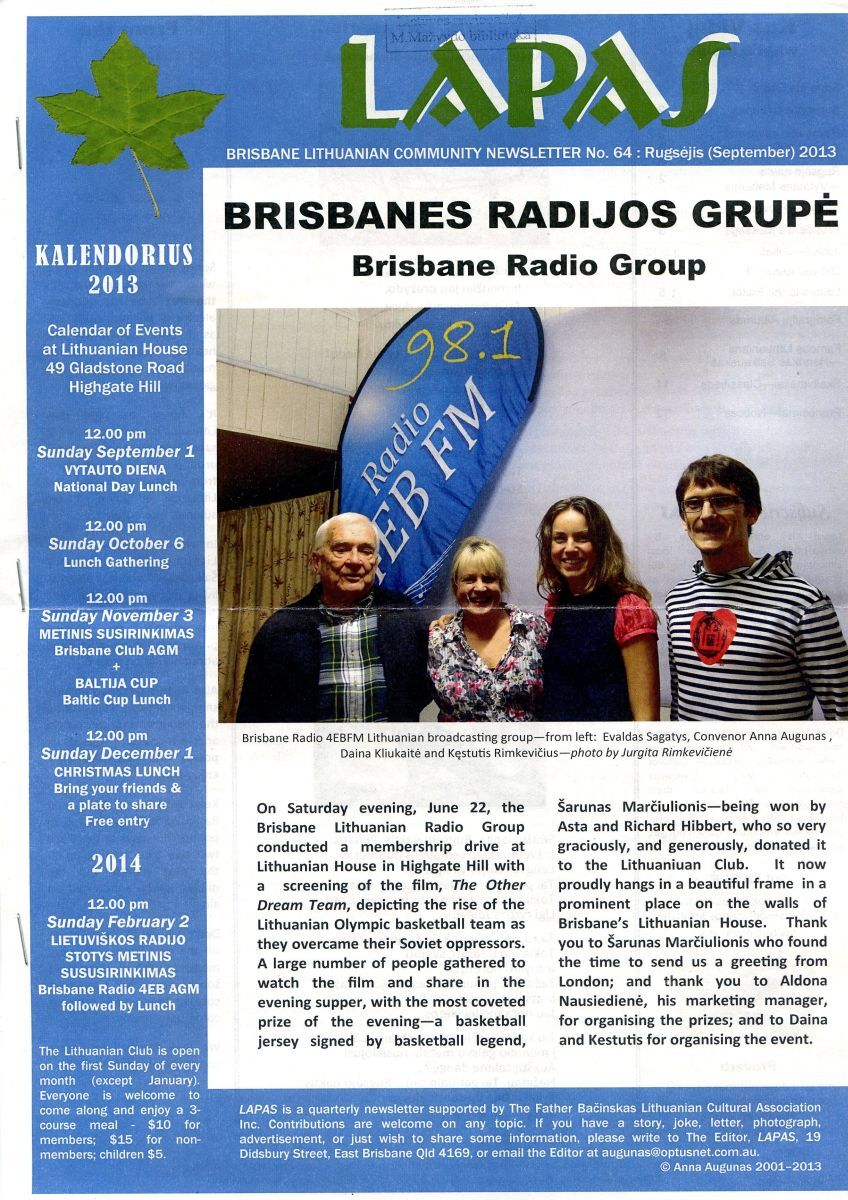
Front page of The Page, No. 64, September, 2013
The Page
Lapas
When Anna Augunas, the future editor of The Page (called Lapas in English as well) settled in Brisbane and began attending the Lithuanian Club, she noticed that many members spoke little or no Lithuanian.
At her request, community members gave her their Lithuanian contacts in 2001, before the first issue appeared. Augunas also looked through the Brisbane telephone directory for Lithuanian names. She sent the first issue to 200 people. In 2002 the publication had grown to 12 pages, and became the newsletter of the Brisbane Lithuanian Community. In 2003 there were 80 subscribers paying 8 Australian dollars per year. There was a slight increase in the number of subscribers in 2004 and 2005, and then numbers went into decline. At one time, The Page was sent all over Australia, had several subscribers in Qatar (!), and a few reached as far as Europe. The majority of subscribers lived in Queensland, its largest city being Brisbane. All subscription fees went to the Lithuanian Club to cover publishing expenses. The subscription was basically a donation to the newsletter.
Augunas wrote articles about the activities at the club, and self-published the newsletter at home, applied the postage and mailed it herself so that subscribers would receive it on time. She said it was heavy work for her home printer – she went through four of them over 13 years.
Articles also came from the Lithuanian communities in Sidney and Brisbane, although the authors were often left unmentioned. One such author asked the editor why his name was missing, and she replied that if she added authors’ names, hers would be on every page. Over the years, the newsletter changed very little. Augunas said that readers liked the familiar format, and loved to see their photos in it.
The new wave of Lithuanian immigrants did not take an interest in The Page. Electronic publishing was attempted in 2005, but became pointless because readers would make copies and distribute them to friends. The editor decided to go back to the paper format, and send the electronic version abroad only. In 2014, in the 69th issue, Augunas announced that both she and The Page needed a holiday.
The history of The Page, as told by the editor (in English).

